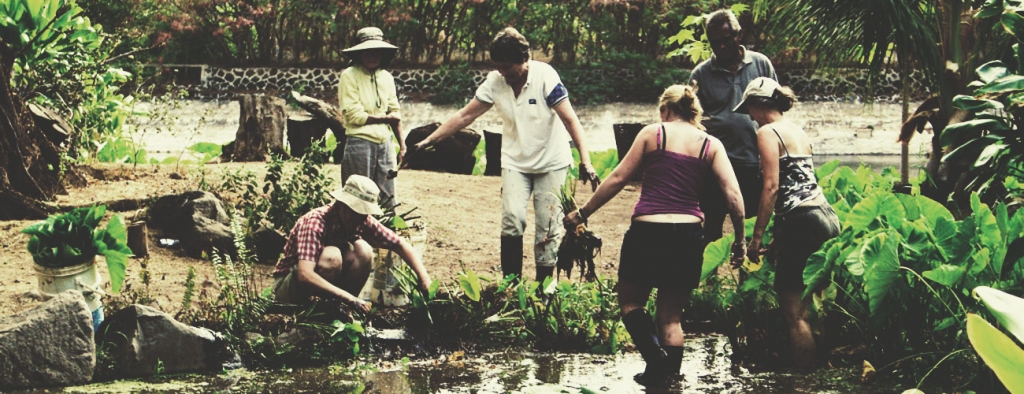Why is it important?
When Ekolu Lindsey’s son Kaleo was 4, he asked Grandpa Ed that question. It was a question no one had asked before. This was the answer he received: “Why is it important? It’s because it’s who we are. It’s the very foundation. If we lose these things, then who are we? We become just voices in the wind. If we lose the cultural sites, then there’s no story left to tell, there’s no foundation for people to grow upon. You can’t see it, you can’t feel it or smell it; you would just have to read it in a book.”
Honokowai Valley
Honokowai is where it all began. Extensive archeological surveys of Honokowai Valley conducted in 1999 revealed that beneath the tangle of foliage lay numerous archaeological sites, including homes, farms, trails and heiaus (places of worship). These findings showed that within the valley was once a thriving, self-sufficient village of about 600 families, likely dating from more than a century ago.
By the 1920s, sugar dominated the islands’ economy, and streamwater was diverted for its cultivation. Without a source of fresh water, the sustainability of the village vanished, and families had to abandon the valley and find new ways to live.
In 2002, when Ed Lindsey founded Maui Cultural Lands to facilitate the restoration of cultural sites, Honokowai was number one on the list. As the most historically significant in the region, with the most prolific archaeological remains, the site deserved immediate attention.
Progress:
Working diligently since 2002, volunteers have cleared more than 10 acres of the valley, uncovering miles of rock walls, along with home sites and heiau. Volunteer efforts have planted thousands of native plants and trees, restored lo‘i for dryland taro, planted vegetable gardens, and even built a simple hale.
Objectives:
Much is still left to do, as the archeological remains extend far up into the valley. In addition, weeds quickly take over the cleared areas, necessitating constant maintenance.
Kaheawa – Hanaula
High above the windswept cliffs of McGregor Point, a line of tall white windmills climbs up into the mists of Hanaula. The native Hawaiian forest is now the home of Kaheawa Wind Power, one of the largest wind farms in Hawai‘i.
Maui Cultural Lands was enlisted by owner First Wind to restore the area’s native habitat, which was disrupted by installation of the giant turbines. The wind farm, completed in 2012, has a total capacity of 51 MW and serves 18,700 homes.
With family history in the area since the 1970s, the Lindsey ‘ohana takes volunteers up the steep slopes every weekend to clear away the invasive species like ironwood, fireweed and molasses grass. These intruders are drought-tolerant and aggressive, choking out the natives and spreading over the hillsides. By removing them, we are able to plant a‘ali‘i, ‘ohia lehua, pili grass and other natives that once flourished in this windswept area.
Progress:
Through steady work over the years, volunteers have been able to clear large areas of aggressive invasive species, resulting in the successful return of more than 24,000 native plants.
Objective:
Ongoing stewardship of the area ensures that all the plants which were removed are returned to their native habitat. Our goal is to eradicate the alien threat and help the Hawaiian plants to thrive in as close to a pre-contact environment as possible.

Launiupoko
If weather in Honokowai Valley is inclement, we will often take volunteers to Launiupoko instead. Just south of Lahaina, this ancient site was once home to a vibrant heiau, or temple. Life in ancient Hawai‘i revolved around appeasing the gods, and leaving offerings at heiau was an integral part of village life.
At Launiupoko, Maui Cultural Lands is working to uncover and maintain the lava rock remains of an ancient heiau, cutting away the grass and haole koa, and planting those native species that might have a chance of survival in this arid area.
The slopes were once home to groves of native wiliwili, a useful and attractive tree that thrives in dry and rocky areas. Ancient Hawaiians used the lightweight wood for making surfboards, parts of canoes and floats for fishing. The trees’ flowers and seeds are used in lei making. Decimated in the last decade by the invasive gall wasp, wiliwili is now making a comeback, and Maui Cultural Lands hopes to help restore the native species to Launiupoko.
Progress & Objectives:
Basic clearing has been done, but invasive weeds quickly take over cleared areas, necessitating constant maintenance. Maui Cultural Lands aims to reintroduce wiliwili trees to the area, using keiki (young) wiliwili from Honokowai Valley. With continued work, this important cultural site can be fully restored and preserved for future generations.
Ukumehame
Through our work to restore the lo‘i kalo at Ukumehame, Maui Cultural Lands hopes to strengthen and preserve the heritage of this revered plant.
Located south of Lahaina in West Maui, Ukumehame is known for its gusty winds that blow from the uplands out to the sea. The waters of Ukumehame Gulch flow from the wet interior of Mauna Kahalawai (West Maui Mountains) down through deep valleys. Here, Ancient Hawaiians once maintained fertile green acres of lo‘i kalo (taro patches).
Brought to Hawai‘i by canoe from Polynesia, taro was a staple of the Ancient Hawaiian diet and was revered for its mana, or life force. Farming taro was a way of life for much of the population. Although today less than 1 percent of the state’s current population still cultivates taro, the plant remains an essential part of Hawaiian culture.
Progress & Objectives:
The ancient lo‘i have been partially restored; however much work remains to be done. Lo‘i kalo require constant, diligent attention in weeding, planting and harvesting. With more hands, the lo‘i can be returned to their original state and thriving production.


